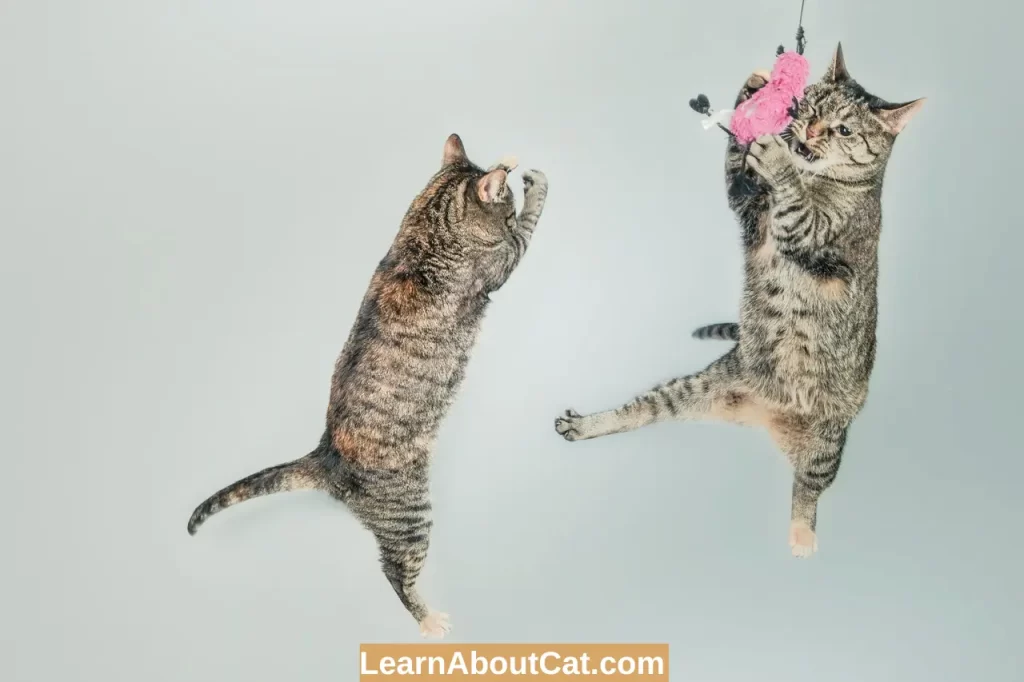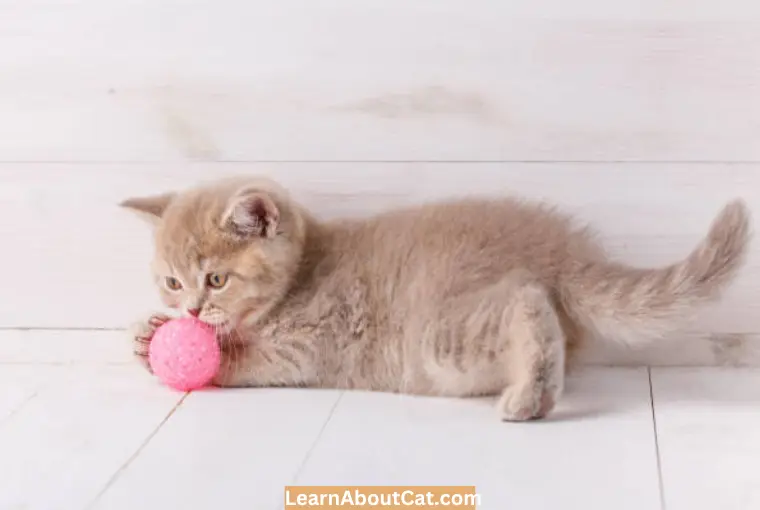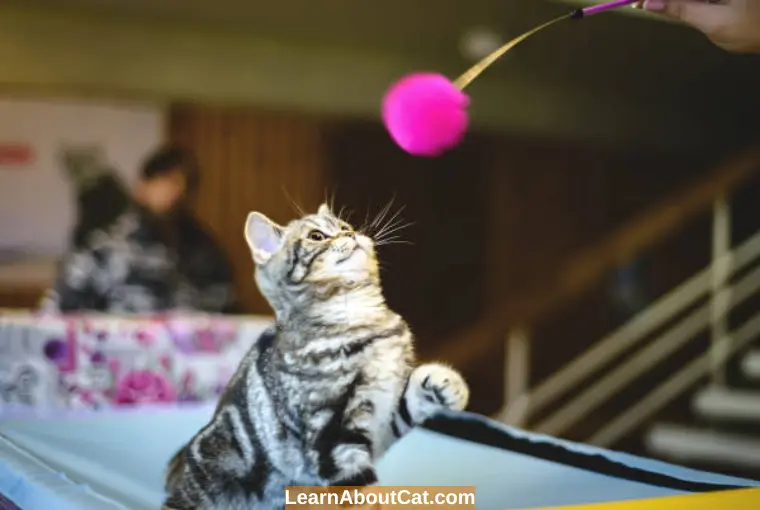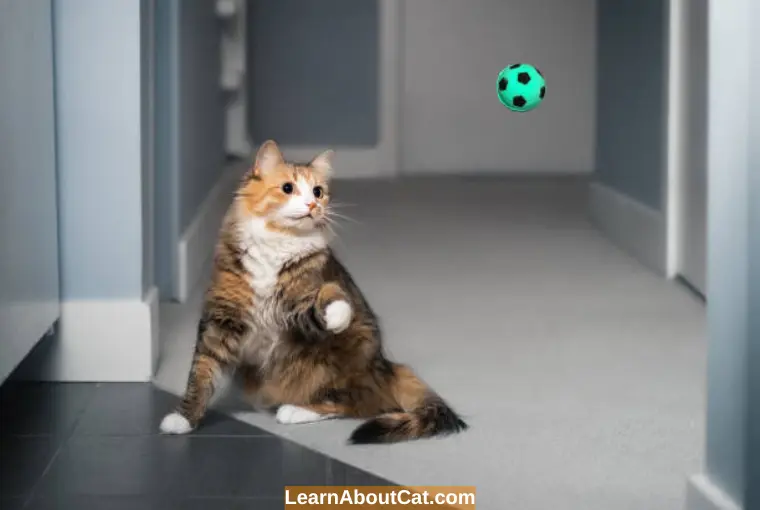Do Cats Play Fetch? How To Train Your Cat To Fetch
Cats are often stereotyped as independent and aloof creatures who prefer to lounge around and nap for most of the day. In reality, if you own a cat, you know that’s not true. Games and other activities can be fun and competitive for cats, especially those who love playing them. One of the most popular games that many cat parents enjoy playing with their feline companions is fetch. But, do cats play fetch?
Yes, some cats do play fetch which can be a great way to bond with your furry friend. While it’s not as common as in dogs, certain felines exhibit this behavior. The tendency to play fetch varies among individual cats, influenced by their unique personalities and environmental factors, it’s worth giving it a try to see if your cat enjoys it. Patient training and positive reinforcement can encourage fetch play in cats.
In this article, we will explore the interesting world of feline fetch, from the reasons behind their behavior to tips on how to teach them to play.

The Science Behind Fetching Games
While we don’t have a lot of scientific research on cats and fetching games, we do know that cats have a natural instinct to chase and catch prey. When cats chase after a toy and catch it, they satisfy this instinct.
When a cat brings the toy back to their owner, it may be trying to show off its catch or seeking praise and attention. It’s also possible that cats enjoy the social interaction that comes with playing fetch with their owners.
The Difference Between Cats and Dogs When it Comes to Fetch
While cats and dogs can learn to play fetch, there are some key differences in how they approach the game. Dogs are known for their innate desire to retrieve objects, which is a trait that has been selectively bred in many dog breeds. In contrast, cats are more independent and have not been bred for any specific task, including fetching.

However, cats are naturally curious and enjoy playing with objects that move or make noise. Some cats may even bring toys to their owners as a way to initiate play. The key to teaching a cat to fetch is to tap into its natural instincts and make the game fun and rewarding for them.
With patience and practice, many cats can learn to enjoy playing fetch just as much as their canine counterparts.
Why Do Cats Play Fetch?
There is nothing strange about cats playing fetch; they are known for their curious and quirky behavior. While not all cats play fetch, those that do may do so for various reasons, including instinctual behavior, bonding with their owners, and mental stimulation.

1. Instinctual Behavior
One reason why some cats may enjoy playing fetch is because of their instinctual behavior. Cats are natural predators, and many enjoy stalking and pouncing on objects that move.
Fetching allows cats to satisfy their hunting instincts in a safe and controlled environment. By chasing after and retrieving toys, cats are able to engage in the form of play that mimics their natural behaviors.
2. Bonding with Their Owners
Cats are often stereotyped as aloof and independent, but many cats crave attention and affection from their owners.
A cat’s bond with its owner can be strengthened through playing fetch. When a cat brings a toy back to their owner, they are demonstrating trust and a desire to interact.
Fetching can also be a great way for owners to spend quality time with their cats and strengthen their bond.
3. Mental Stimulation
It is essential for cats to be stimulated mentally in order to remain healthy and happy. Having fun playing fetch can stimulate cats’ minds and make them more capable of thriving.
By engaging in a game of fetch, cats are able to use their problem-solving skills to figure out how to retrieve and bring back toys.
The mental stimulation this type of activity provides can prevent cats from becoming bored and anxious.
The Benefits of Playing Fetch with Your Cat
Playing fetch with your cat can provide several benefits, both for your cat and for you.
- Playing fetch can help your cat burn off excess energy, improve their physical and mental health, and strengthen its bond.
- For you, playing fetch with your cat can be a fun and engaging way to spend time together and strengthen your relationship.
How to Teach a Cat to Fetch

1. Find a Quiet Place
When you want to keep your cat’s attention, it’s frequently best to teach it anything new in a place where there are no outside distractions. Find a quiet spot in the house, ideally one with minimal obstacles. Choose a compact, enclosed space. You can switch to a bigger area as your cat improves at the game.
2. Choose the Right Toy
Most cats choose their favorite objects to fetch. Paper wad, catnip mouse, or a glittery ball could be the options to train them for fetching. Some cats like nothing more than pursuing food on a rough surface.
3. Outfox a Cat
Moore suggests showing him the treat if his cat grabs the toy but won’t let go. He will drop the toy in order to get the treat. When he does, thank him by saying “great fetch” and giving him the toy with your other hand. You need to increase the toy’s value. So, make it the toy of choice for them. This makes it more appealing to the cat.
Your cat will hear that it’s time to fetch if she is close when you open the drawer or cupboard and will hurry inside if she is.
4. Game Development
You can advance to the next level if your cat has mastered fetch. Sit with a friend at the opposite ends of a hallway. Placing your cat in the center, toss the toy over her head in the manner of “Monkey in the Middle.”
5. Tell them, “It’s time to enjoy!
Your cat doesn’t need to play fetch all day, so only do it for 3 to 5 minutes at a time. Continue to build on little achievements.
One or two fetches are all your cat can manage before losing interest. End the session when that occurs.
Keep in mind that you and your cat should both appreciate this. Never make your cat perform an action that she doesn’t want to.
6. Make the Toy More Valuable
Picking up any objects that have been left lying around the house is essential. According to Moore, if this is not done, the thing will depreciate. Find a special place to keep the toy, such as a drawer or cabinet, and keep it there all the time.
7. Select the Appropriate Time
Since timing is crucial and you are the authority on your cat’s habits, choose a time when you are certain that your cat is ready for a game. Some cats prefer to be fetched before a meal, while others do not.
Cats are skilled runners and dashers. Ten minutes is a long time in the world of cats, and you want to go to your cat wanting more. Cats normally tire of the game for around five minutes, at which point you must end the game.
8. Give the Game a Name
Cats meow, move their eyes and tail, and fluff their hair to communicate, but cats can also understand a variety of human words.
After luring your cat with the toy from across the room, call out something like Fetch, kitty-kitty in a cheery, high-pitched voice. The command ‘come’ can be used with the word fetch if your cat has already been taught to respond to a clicker call.
9. Promote the Initiative
Simply picking up the toy and throwing it again acts as a sufficient reward for cats who naturally retrieve it. Eating the kibble or other treats that your cat chases around the floor is its main motivation. Once more, take your cat’s lead and reward it with the things it likes to encourage good behavior.
Tips for Success
- Use positive reinforcement, such as treats and praise, to encourage your cat to play fetch.
- Start with short throwing distances and gradually increase the distance as your cat becomes more comfortable with the game.
- Be patient and persistent – not all cats will learn to fetch right away
- Make sure your cat has plenty of space to move around and play safely
Common Mistakes to Avoid
- Don’t force your cat to play fetch if they are not interested or comfortable with the game.
- Avoid using harsh or negative reinforcement, such as yelling or punishment, as this can scare your cat and damage your relationship with them.
- Don’t overdo it – cats need plenty of rest and relaxation time, and too much play can be overwhelming for them.
Common Misconceptions about Cats and Fetching Games
Cats are often stereotyped as independent and solitary creatures who are not interested in playing with their owners. However, this is a common misconception, and many cats enjoy playing games such as fetch.

Another misconception about cats and fetch is that only dogs are capable of playing this game. While it’s true that dogs are often known for their love of fetching, cats can also learn and enjoy this game.
Additionally, some people believe that cats are not as trainable as dogs and that teaching a cat to play fetch is impossible. However, cats are intelligent animals who can learn various tricks and behaviors, including playing fetch.
Finally, some people may think that playing fetch with a cat is not as rewarding as playing with a dog. You can strengthen your bond with your cat by playing fetch with him, and it can be just as fun and enjoyable for both you and your cat.
Many distinctive characteristics make cats unique, and it is important to remember them when you are handling them. While some cats may not be interested in playing fetch, many others enjoy this game and can be trained to play with their owners.
Are cats who play fetch smart?
While there’s no concrete scientific evidence correlating fetch play with overall cat intelligence, many experts argue that the mental stimulation provided by such activities can contribute to a cat’s overall well-being.
It does indicate a certain trainability and responsiveness to stimuli. Cats engaging in fetch demonstrate cognitive ability, suggesting that they are quick learners and capable of adapting to interactive activities.
Moreover, the interactive nature of fetch can enhance the bond between a cat and its owner, fostering a deeper connection through shared play experiences.
Also, Check Out: Cat Myths And Misconceptions: Know The Truth
Which Cat Breeds Engage In Fetching?
While not all cats enjoy playing fetch, some breeds are more likely to engage in this activity. Here are some cat breeds that are known to enjoy fetching:
- Siamese: This breed is known for its intelligence and high energy level, which makes it great at playing games like fetch.
- Ragdoll: Ragdoll cats love to play and are easily trained. They can learn to play fetch with their owners and hide and seek with them if they are trained properly.
- Sphynx: These hairless cats are highly active and love to play, making them great candidates for playing fetch.
- Bengal: Bengals are known for their athleticism and love of play, which makes them excellent fetch players.
- Burmese: These cats are highly social and love to play, making fetch fun.
- Devon Rex: These cats are known for their playful and mischievous personalities and often enjoy playing fetch.
- Abyssinian: This breed is highly active and intelligent, and they enjoy playing games that involve fetching and chasing.
Of course, every cat is an individual, and some cats of other breeds may also enjoy playing fetch. Not all cats enjoy this activity, and it’s always best to let your cat lead the way when it comes to playtime.
Frequently Asked Questions
Do all cats play fetch?
No, not all cats are interested in playing fetch. While many cats can be trained to enjoy the game, some simply prefer other forms of play. Each cat is unique, so toys and activities will vary from one to another
Can all cats learn to play fetch?
While not all cats are interested in playing fetch, many cats can learn to enjoy the game with patience and practice.
What toys are best for fetch?
You can use a variety of toys to make it a fun game if your cat loves to play fetch. Some popular options include small balls, soft toys, and crinkly or noisy toys.
Choose a toy that your cat is interested in and willing to chase after. It’s also important to choose a toy that is safe for your cat to play with and doesn’t pose a choking hazard.
Can older cats learn to fetch?
Yes, older cats can learn to play fetch, but it may take more time and patience than with younger cats. It’s important to choose a toy that is easy for your cat to pick up and carry and to start with short throwing distances.
Always be patient and positive, and reward your cat for its efforts. Older cats can enjoy playing fetch just as much as younger cats with time and practice.
Is playing fetch with my cat good for their health?
Yes, playing fetch can help cats burn off excess energy, improve their physical and mental health, and strengthen your bond with them.
What should I do if my cat isn’t interested in playing fetch?
If your cat isn’t interested in playing fetch, don’t force them to do so. Instead, try playing with different types of toys or games that your cat enjoys.
Wrap Up!
Teaching your cat to fetch can be a fun and rewarding experience for both you and your furry friend. By choosing the right toy, starting small, and practicing regularly, you can help your cat learn to love playing fetch.
Remember, every cat is unique, and some may take longer to learn than others. Be patient and consistent in your training, and always remember your cat’s comfort and safety. With time and practice, you and your cat may just become the ultimate fetch-playing duo!
Related Posts:
Who is Isabella?
My name is Isabella, and I am a dedicated and knowledgeable cat enthusiast. With years of experience caring for cats and a deep love for felines, I made a mission to help other cat lovers navigate the challenges of cat ownership.






